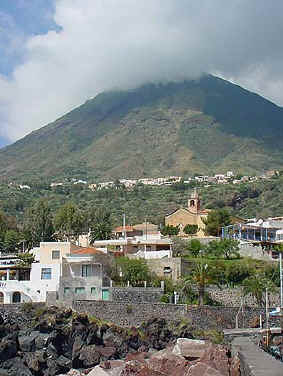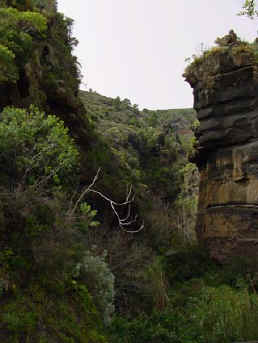
Salina, owing to its central position, constitutes, a centre for excursions to the other Aeolian islands.

Salina, owing to its central position, constitutes, a centre for excursions
to the other Aeolian islands.
|
|
Salina is the ancient Didyme (= twin), name derived from the shape of the island: two reliefs separated by a saddle. The present name originates from a coastal lake which once was utilised as a "salt-pan". It is situated along the Lingua point; it has a depth of a few metres and an extent of almost two hectares. The coastal cordons encircling it are formed by the strong marine currents which cross the channel between Salina and Lipari. The island has an almost trapezoidal form and a total coastal area of 24 square Kms. In the archipelago group Salina occupies second place as regards extent and the number of inhabitants; it holds first place, instead, with regard to the fertility of the soil. From an administrative point of view one must point out that, whilst the other Aeolian islands form one single commune, i.e. that of Lipari, the island of Salina alone is divided into three communes and namely those of Santa Marina Salina, Malfa and Leni. |
| The island is made of two mountain ranges - to the East, M. Fossa delle Felci and M. Rivi, connected between them by a ridge; to the West Monte dei Porri connected by a saddle from which depart, to the North towards Malfa, the valley of Gavite, to the South towards Rinella, the Vallonazzo. Almost in the mean line, oriented North-South, the depression of Valdichiesa separates the two mountain ranges. Three main geological formations make up the island: two of the Pleistocene (Middle Pleistocene) and one of the Wurm Age. A great gaping crater to the East on the sea, whose summit is Monte dei Rivi, characterizes the first of these formations; the Mount Fossa delle Felci, subsequently formed through powerful lava effusions, ejections of scoriae, deposits of tuffs and breccia, covering a large section of the Southern side of Monte dei Rivi, reppresents the second. The crater of Mount Fossa delle Felci has a diameter of about 500 m and makes up, though partly eroded, one of the most evident shapes of all the Archipelago; the third, of the Wurm Age, is made of one volcanic cone: Monte dei Porri. On the Western side an ample crater opens, only partly preserved, the bottom of which makes up an inclined plateau from 50 to 100 metres on which the built-up area of Pollara is situated. The island is made of six volcanoes. The most ancient ones found at Pizzo di Corvo, Monte Rivi and near Capo Faro are not easily recognizable in their morphological structure, while the stratum volcanoes of Fossa delle Felci and Monte dei Porri conserve an almost perfect shape. |
|
 |
The latest eruption took place in the west portion of the island, about thirteen thousand years ago, and brought about the crescent shaped crater of Pollara; such activity, mainly explosive, produced great pumice deposits. In various localities of the island one encounters endogenous activities. On Monte Rivi (854 m. a.s.l.) one sees an ancient volcanic building, today for the most part dismantled, made by lava of andesitic and basaltic nature. On the Fossa delle Felci (962 m. a.s.l., the highest summit of the Aeolian Archipelago), of typical conical shape, opens up a crateric cavity, less ancient than the preceding one, formed solely of andesitic rocks. The remains of these two craters are to be found in the Eastern part of the island; in the Western part one encounters as many as three volcanic establishments: that of Pizzo del Corvo formed by andesitic lava, that of the Monte dei Porri formed by andesitic and basaltic lava and finally the crater of Pollara, in which one sees the characteristic white pumice stone of mica and orneblenda andesite. Of endogenous activity extinct since time immemorial, there remain as modest residues, certain post-volcanic phenomena and precisely the "sconcassi" and a hot spring, which gushes in the Pertuso locality. The "sconcassi" appears in the proximity of Rinella and consists of an extensive underwater emanation of gas (sulphurated hydrogen) and of vapour. The exhalation, when accentuated, causes a disturbance of the sea bed. |
| The high
slopes of the island are covered by ilexes, poplars, chestnut trees and
the typical Mediterranean bush composed mainly of broom, myrtle, and
strawberry trees. The medium and lower slopes are, often terraced and
dotted with caper bushes, prickly pear and various cultures such as:
orchards, olive groves and vineyards. Amongst the products are worthy of
particular mention the red wine for its aroma and high alcoholic content
and, above all, the renowned white wine (malvasia), of which Salina is the
largest producer in the Archipelago, in consideration of the fact that in
other islands this culture has been abandoned. The "Malvasia"
has a golden yellow colour, strong aroma with a delicately sweet flavour.
The production of Capers is considerable and is mainly
exported. Unfortunately various cultivable areas are today abbandoned owing to lack of labour caused by extensive transoceanic emigration (a phenomenon, on the other hand, common to the other sister islands of the Aeolian Archipelago) directed mainly towards the New World. |
 |
 |
A circular trip around the island offers indelible sights owing to its high, sombre coasts, its characteristic immersed terraces, pleasant small beaches and inhabited centres, the typical small white houses, nestled along the sea and half way up the coast. The typical architecture of the houses of the island has still not suffered modification. The prevalent type of habitation is represented by single storey buildings with terrace roof, with pergola supported by columns. Only in the inhabited centres does one note houses with an upper storey. On the whole the island is very picturesque and it is easy to admire its panoramic beauty owing to the efficient road network, which connects the various localities. Of particular interest are the coastal carriageable roads connecting Santa Marina Salina, the largest centre of the island, with Lingua (to the South) and Malfa (to the North West), No less interesting, from the panoramic point of view, is the road which crosses the Vallonazzo, the enchanting Val di chiesa (saddle at 285 m. a.s.l.), rich in vineyards, and the Valle dei Giovi. This road connects the landing stage of Rinella with Leni and, subsequently, with Malfa. Along the road emerges, in a dominant position, the well known Sanctuary of the Madonna del Terzito, which dates back to the early date of 1630 and which, from then, constitutes the goal of frequent pilgrimages. |
| The sea surrounding the island is rich with fish fauna. The fishing of "cicirella", sauria, anchovies, sardines, "pesantoni", "occhiate" and of "ope" is abundant. The fishing of sword fish is carried out with excellent results. The remarkable natural patrimony of the mountains Fossa delle Felci and dei Porri has been protected by an oriented natural reserve, created to allow an armonic development between vegetable and animal species. Also the island of Salina has had considerable importance during the Bronze Age.There have been identified two establishments of that Age on the Eastern coast. The first on the Serra dei Cianfi which flourished during the Age of Capo Graziano (between the XVIII and the XV century B.C.) and at the beginning of the successive Age of the Milazzese (after 1400 B.C.). The second in a much more inaccessible position but more suitable for the defence of the Portella on the road Santa Marina-Malfa. This latter flourished entirely during the Milazzese Age and has been violently destroyed perhaps around the year 1270 B.C. (material of the excavations is at the Aeolian Museum ot Lipari). Traces of an establishment of the VI-V century B.C. at Serro dell'Acqua. A Greek habitation of the IV century B.C. and later, lasting until the imperial Roman Age, was on the site of the present city of Santa Marina. One sees traces of houses along the beach. On the mountain side of the city were found numerous tombs of that Age. Sporadic traces of Greek and Roman ages have been seen in numerous parts of the island. In the swamp which constitutes the Punta Lingua and that is, the Eastern extremity of the island of Salina (swamp which was one used as a salt-pan from which, in fact, the island derives its present name) exist remains of ancient buildings, which at the end of the XVIII century appeared with evidence above ground and which today are interned and no longer visible on the surface. They are walls of the most typical "opus reticulatum" of the I-II century A.D., belonging to a construction of lmperial Roman Age, which existed near the North Western margin of the ex Salina and probably extended also beyond it to the foot of the slope behind. The higher part was destroyed during last two centuries, the lower buried part is still preserved, as the best evidence of the Roman Age. |
  |